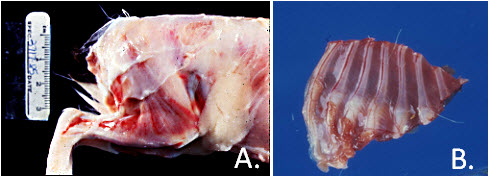Etiology: Guinea pigs lack the hepatic enzyme 1-gulonolactone oxidase, which is essential for the conversion of L-gulonolactone to L-ascorbate. Guinea pigs require ascorbate in their diet in order to synthesize collagen and intracellular ground substance as well as for the catabolism of cholesterol into bile acids.
Incidence: Incidence is rare in laboratory guinea pigs due to stable vitamin C in modern formulated diets.
Clinical signs: Scurvy is a painful disease, characterized by frequent vocalizations, weakness, anorexia, diarrhea, stiffness, reluctance to move, petechia of the mucous membranes, subcutaneous hemorrhages and death in two to three weeks due to starvation or secondary infection. Other nonspecific but suspicious signs may include rough hair coat, delayed wound healing, teeth grinding, inactivity, stillbirths, and chronic disease.
Pathology: Gross necropsy findings may include fascial and articular cartilage hemorrhages, petechial and ecchymotic bleeding on the periosteum, muscle (A.), and gingiva. Ceostochondral regions are often enlarged (B.).
Diagnosis: A diagnosis can be made by dietary history, gross pathology, and serum ascorbate levels.
